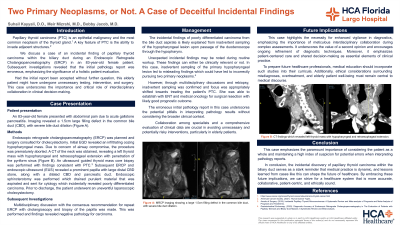Tuesday Poster Session
Category: Biliary/Pancreas
P2996 - Two Primary Neoplasms or Not
Tuesday, October 24, 2023
10:30 AM - 4:00 PM PT
Location: Exhibit Hall

Has Audio

Suhail Kayyali, DO
Largo Medical Center
Largo, FL
Presenting Author(s)
Meir Mizrahi, MD1, Bobby Jacob, MD2, Suhail Kayyali, DO3
1Largo Hospital, Largo, FL; 2HCA Florida Largo Hospital, Largo, FL; 3Largo Medical Center, Largo, FL
Introduction: Papillary thyroid carcinoma (PTC) is an epithelial malignancy and the most common neoplasm of the thyroid gland. A key feature of PTC is the ability to invade adjacent structures. We discuss a case of incidentally discovered PTC during endoscopy. There are no literature to support any relation between PTC with bile duct cancer.
Case Description/Methods: An 83 year old female presented with abdominal pain due to acute gallstone pancreatitis. CT imaging revealed a 1.5cm large filling defect in the common bile duct (CBD), with severe bile duct dilation. Endoscopic retrograde cholangiopancreatography (ERCP) was planned and surgery consulted for cholecystectomy. Initial EGD revealed an infiltrating oozing hypopharyngeal mass. Due to concern of airway compromise, the procedure was prematurely aborted. A CT of the neck was obtained, revealing a left thyroid mass with hypopharyngeal and retroesophageal extension with penetration of the pyriform sinus. An ultrasound guided thyroid mass core biopsy was performed with findings consistent with PTC. Subsequent ERCP and endoscopic ultrasound (EUS) revealed a prominent papilla with large distal CBD stone, along with a dilated CBD and pancreatic duct. Endoscopic sphincterotomy was performed which drained purulent material that was aspirated and sent for cytology which incidentally revealed poorly differentiated carcinoma. Prior to discharge patient underwent an uneventful laparoscopic cholecystectomy. Multidisciplinary discussion with the consensus recommendation for repeat ERCP with cholangioscopy and biopsy of the papilla was made. This was performed and findings revealed negative pathology for carcinoma. The incidental findings of poorly differentiated carcinoma from bile duct aspirate was likely explained from inadvertent sampling of the hypophyarngeal lesion upon passage of the duodenoscope through the hypopharynx.
Discussion: Unexpected incidental findings may be noted during routine workup. These findings can be either clinically relevant or not. In this case, inadvertent sampling of the primary hypopharyngeal lesion led to misleading findings which could have lead to incorrectly pursuing two primary neoplasms. However, through multidisciplinary discussions and rebiopsy, inadvertent sampling was confirmed and focus was appropriately shifted towards treating the patient's PTC. She was able to establish with ENT and medical oncology for surgical resection with likely good prognostic outcome.
Disclosures:
Meir Mizrahi, MD1, Bobby Jacob, MD2, Suhail Kayyali, DO3. P2996 - Two Primary Neoplasms or Not, ACG 2023 Annual Scientific Meeting Abstracts. Vancouver, BC, Canada: American College of Gastroenterology.
1Largo Hospital, Largo, FL; 2HCA Florida Largo Hospital, Largo, FL; 3Largo Medical Center, Largo, FL
Introduction: Papillary thyroid carcinoma (PTC) is an epithelial malignancy and the most common neoplasm of the thyroid gland. A key feature of PTC is the ability to invade adjacent structures. We discuss a case of incidentally discovered PTC during endoscopy. There are no literature to support any relation between PTC with bile duct cancer.
Case Description/Methods: An 83 year old female presented with abdominal pain due to acute gallstone pancreatitis. CT imaging revealed a 1.5cm large filling defect in the common bile duct (CBD), with severe bile duct dilation. Endoscopic retrograde cholangiopancreatography (ERCP) was planned and surgery consulted for cholecystectomy. Initial EGD revealed an infiltrating oozing hypopharyngeal mass. Due to concern of airway compromise, the procedure was prematurely aborted. A CT of the neck was obtained, revealing a left thyroid mass with hypopharyngeal and retroesophageal extension with penetration of the pyriform sinus. An ultrasound guided thyroid mass core biopsy was performed with findings consistent with PTC. Subsequent ERCP and endoscopic ultrasound (EUS) revealed a prominent papilla with large distal CBD stone, along with a dilated CBD and pancreatic duct. Endoscopic sphincterotomy was performed which drained purulent material that was aspirated and sent for cytology which incidentally revealed poorly differentiated carcinoma. Prior to discharge patient underwent an uneventful laparoscopic cholecystectomy. Multidisciplinary discussion with the consensus recommendation for repeat ERCP with cholangioscopy and biopsy of the papilla was made. This was performed and findings revealed negative pathology for carcinoma. The incidental findings of poorly differentiated carcinoma from bile duct aspirate was likely explained from inadvertent sampling of the hypophyarngeal lesion upon passage of the duodenoscope through the hypopharynx.
Discussion: Unexpected incidental findings may be noted during routine workup. These findings can be either clinically relevant or not. In this case, inadvertent sampling of the primary hypopharyngeal lesion led to misleading findings which could have lead to incorrectly pursuing two primary neoplasms. However, through multidisciplinary discussions and rebiopsy, inadvertent sampling was confirmed and focus was appropriately shifted towards treating the patient's PTC. She was able to establish with ENT and medical oncology for surgical resection with likely good prognostic outcome.
Disclosures:
Meir Mizrahi indicated no relevant financial relationships.
Bobby Jacob indicated no relevant financial relationships.
Suhail Kayyali indicated no relevant financial relationships.
Meir Mizrahi, MD1, Bobby Jacob, MD2, Suhail Kayyali, DO3. P2996 - Two Primary Neoplasms or Not, ACG 2023 Annual Scientific Meeting Abstracts. Vancouver, BC, Canada: American College of Gastroenterology.
